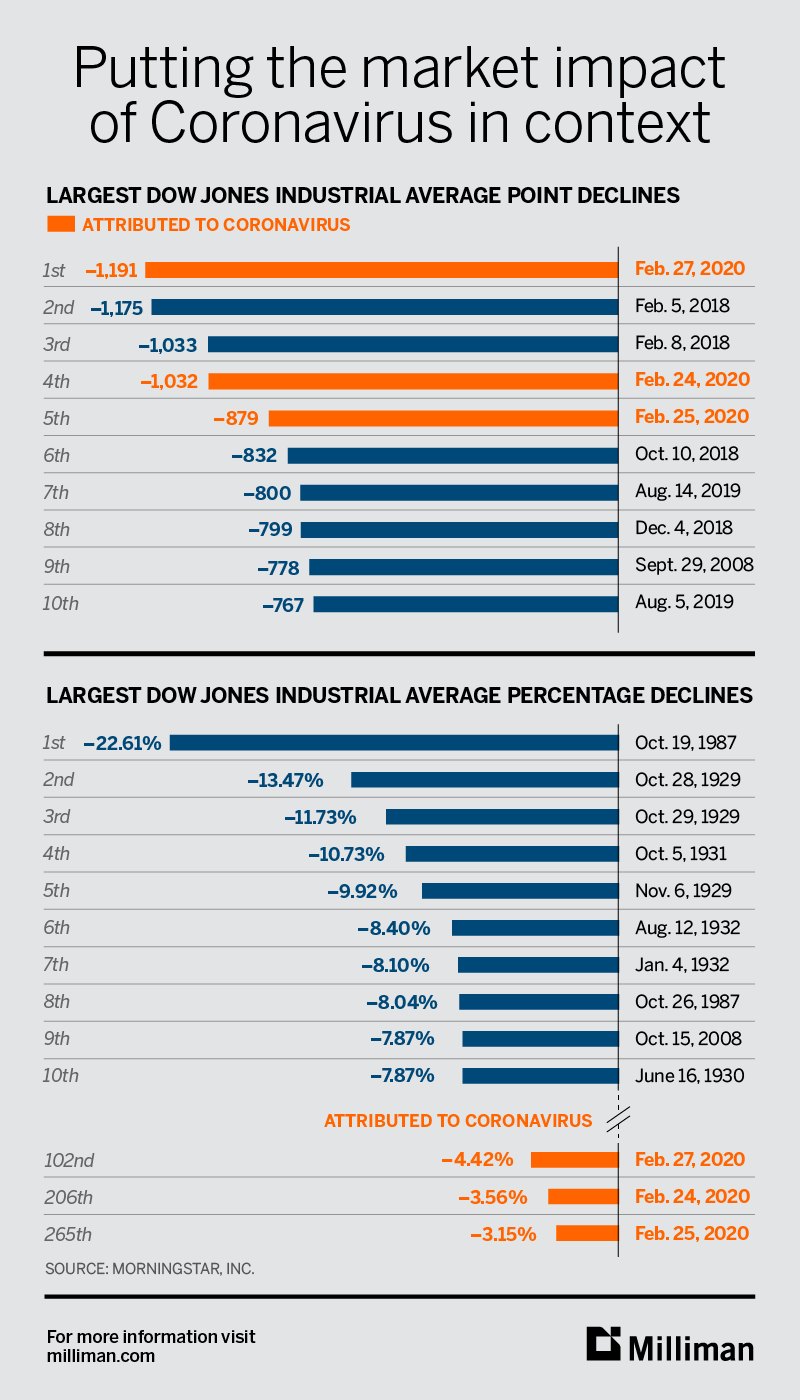
Over the last couple of days we have seen steep declines in global equity markets driven by concerns related to the coronavirus (COVID-19). Since February 20, in particular, we have seen three large declines, including two drops of 1,000+ points in the Dow on higher market volatility. Markets don t like uncertainty.
The 1,190.95-point Dow decline this past Thursday (February 27, 2020) is the largest we've seen in the history of the Dow and amounts to a drop of over 4.4%. However, when compared to the daily historical percentage-point drops in the Dow, it ranks around 100th in terms of percentage declines dating back to the 1920 s. The largest percentage decline in the Dow occurred on October 19, 1987, also known as Black Monday. On that day, the Dow fell more than 500 points, which represented a decline of more than 22%, because the Dow was at about 2,200 at the time. So while the 1,000-point drop is substantial, we need to put this into perspective in terms of the level of the Dow today and the percentage of the decline.
Factoring in the declines over six trading days last week (February 20 to February 27), we re close to a 13% decline in the span of four trading days for the Dow (and S&P 500). This is a market correction (typically defined as a 10% decline or more). For perspective, there have been six market corrections since the recovery began in 2009 after the global financial crisis.

So what is driving the decline?
Concerns and headlines related to the spread of COVID-19 and the level of containment as well as the accompanying uncertainty regarding this issue.
From the World Health Organization, it is reported that there are 83,652 cases (as of February 28, 2020) with 1,358 new cases reported in the last couple of days; at this point there have been over 2,700 deaths in China related to COVID-19. Cases have now spread to six continents.
As such, it cannot be predicted how this will play out in the near or long term nor what the overall impact will be on global economies. Some of the potential effects include: a reduction in travel, commerce slowing due to lower employee productivity and the disruption of supply chains, and the market generally trying to price in a reduction in expected corporate profits due to potential increased expenses. Given that, the bigger question is what the magnitude of these impacts will be. Will supply chains have to be revamped and inventories built up? Will production become more locally focused? Until we have a better understanding of these questions and how they could affect earnings, we expect to see elevated volatility across markets.
So what should I do?
While volatility will likely remain elevated, it is still within the range that is normal and expected. Make sure your portfolio is positioned for the appropriate level of risk, which means up markets as well as down markets. Make sure your portfolio is prudently diversified, which usually means owning both equities and fixed income. And finally, make sure your portfolio is structured with the right time horizon. Whether a pension plan or a 401(k), it's unlikely you need all your money in the next few days. Long-term investing can handle the ups and the downs. Make sure you have the right risk for your objectives and the best expert advice in your corner.
The analysis in this report was prepared utilizing data from third parties. Reasonable care has been taken to assure the accuracy of the data contained herein. These reports do not constitute investment advice with respect to the sale or disposition of individual securities. Past performance is no guarantee of future results.
Milliman provides a copy of its SEC Form ADV Part II to clients without charge upon request.Advisory Services are offered through Milliman Advisors, LLC a subsidiary of Milliman, Inc.